Microsoft Surface Pro 2 Review
by Anand Lal Shimpi on October 21, 2013 12:01 AM EST- Posted in
- Tablets
- Microsoft
- Mobile
- Surface
- Surface Pro 2

When Microsoft introduced its first Surface devices last year, it did so in a staggered fashion. Surface RT showed up first, then four months later Surface Pro went on sale. Despite sharing a lot of the same DNA, the response to Surface Pro was much better than what we saw with Surface RT. While Surface RT suffered a lot from being a new platform that lacked the support of decades of Windows applications, Surface Pro had no such issue.
Instead, Surface Pro offered the promise of a tablet that could potentially replace your notebook and desktop as well. Microsoft’s strategy with Surface Pro mimicked the market transition we saw years earlier. The notebooks that replaced desktops over the 2000s did so by being able to work as both notebooks or desktops. Similarly, Microsoft hoped that Surface Pro could act as both a tablet and a notebook for those users who didn’t want to carry two devices.
By and large, Microsoft was successful in achieving that vision. Although as with all devices that attempt to fulfill multiple roles, Surface Pro presented a set of tradeoffs. It wasn’t as portable and didn’t last as long on a single charge as a conventional ARM based tablet. It also didn’t have the same keyboard or in-lap experience as a PC notebook. You got a compromised experience on both sides of the fence. Just as with Surface 2, Microsoft is committed to a more aggressive update cadence to its Surface Pro hardware as well. Here we are, almost 9 months since availability of the original Surface Pro, reviewing its successor.
Unlike Surface 2, Surface Pro 2 shows almost no signs of change on the outside. It reminds me of the pre-iPhone/iPad era where expecting a dramatic chassis redesign a year after introduction was considered ludicrous. Surface Pro 2 keeps the exact same finish, dimensions and weight as the original Surface Pro.
It’s unfortunate given how much thinner and lighter the device could be this time around. I suspect Microsoft has a three year plan for Surface Pro. It could move to a thinner design this year and drop performance by going to a 6W Haswell SKU, keep performance the same but pay a thermal penalty with a 15W Haswell or wait until Broadwell next year to shrink the chassis (hopefully without much of an associated performance reduction). I can understand why Microsoft chose the latter, it’s still just frustrating as I would’ve loved a thinner/lighter Surface Pro.
I also lament Microsoft’s decision to update the VaporMg finish on Surface 2 but not on Surface Pro 2. I really like the new finish both in feel and in color. Surface 2’s resistance to picking up fingerprints is an added bonus on that front. Alas, it’s an update that I’m guessing the Surface Pro lineup won’t get until next year.
Surface Pro 2 also retains the same front and rear facing cameras as its predecessor, both 1.2MP units and it doesn’t get the new 3.5/5MP sensors from Surface 2.
You still get a bundled Wacom active digitizer with Surface Pro 2, just like with the original. I’m hardly a creative professional, but from what I’ve experienced with the pen it’s really a great addition for those folks who are. I’ll point you at none other than Gabe from Penny Arcade who did a great post on an artist’s perspective of using the Surface Pro’s stylus. Spoiler alert: he likes it a lot. If I illustrated for a living, I probably would too.
Surface Pro 2 inherits the same kickstand and branding decisions as Surface 2. As I mentioned in my Surface 2 review, the new 2-stage kickstand is awesome and a huge improvement over its predecessor. The kickstand now opens at 24 and 40-degree angles, the latter enables more comfortable use when you’re not typing at a desk. The new kickstand also ditches the Windows 8 logo in favor of the Surface logo across the back.
Finally, Surface Pro 2 does get the new 1080p panel from Surface 2 (albeit a brighter implementation). There’s no improvement in resolution compared to the original Surface Pro, but color accuracy is a lot better.
I did notice an odd display corruption issue on Surface Pro 2 when waking up from sleep (pictured above). Resetting the device or sometimes just doing another sleep/wake cycle was enough to fix it. Microsoft tells me it’s aware of the problem and plans to issue an update shortly to address it. We only got review samples a few days prior to the NDA lift, I get the impression that it was a lot of work to get final hardware out the door in time for this launch. Update: Microsoft traced the issue back to a later revision of an Intel graphics driver. After release, a Surface Pro 2 update rolled back to an earlier optimized driver that no longer exhibits the display corruption on wake issue.
Internally we see where Microsoft spent most of its time updating Surface Pro. It all starts with an upgrade to Haswell. Surface Pro 2 features Intel’s Core i5-4200U, a dual-core 1.6GHz 15W Haswell part with Hyper Threading, 3MB of shared L3 cache, and a max turbo frequency of 2.6GHz. Just like last time, I had no issues hitting 2.6GHz on Surface Pro 2. I would see 2.3GHz far more frequently however.
As Surface Pro 2 is rather thick by Ultrabook standards, you get the full performance of the 4200U. I ran a multithreaded Cinebench 11.5 test on Surface Pro 2, comparing it to Apple’s 13-inch 2013 MacBook Air under Windows 8. The two deliver identical performance, just in different form factors:
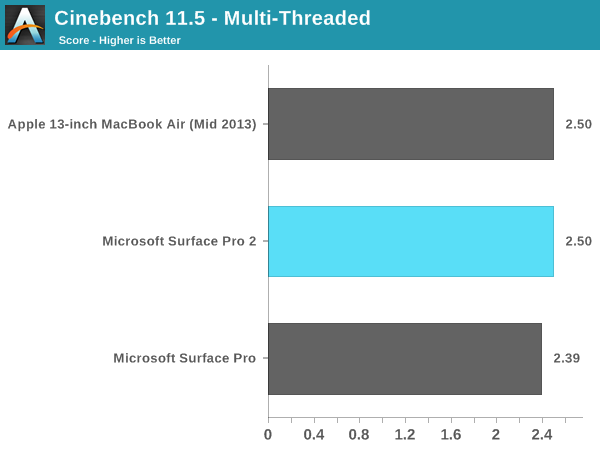
The 4200U is nearly identical to the base CPU you get in the new 2013 MacBook Airs, the only difference being that you get Intel’s HD 4400 graphics vs. HD 5000. Apple’s obsession with graphics performance explains the difference, although it’s disappointing to see Microsoft not sharing the same obsession. To Microsoft’s credit the difference between Intel’s HD 5000 and HD 4400, when constrained by a 15W TDP, just isn’t very large. The real benefit to going with HD 5000 over HD 4400 has to do with power consumption, since you can get similar performance at lower frequencies/voltages thanks to a doubling of the number of EUs in HD 5000.
It’s not just the CPU that’s changed this time around, Microsoft did extensive work under the hood of Surface Pro 2 to further reduce power consumption. Haswell ULT supports LPDDR3, a feature that Microsoft chose to take advantage of in pursuit of lowering power consumption. All other components on the motherboard are also optimized for power consumption. The result is a device that looks like and is cooled similarly to its predecessor, but is appreciably cooler/quieter in operation. While the original Surface Pro would spin its fans up on a regular basis, Surface Pro 2 is far more hesitant to do the same thing. In what I’d consider to be light to medium tablet use, Surface Pro 2 behaves like a passively cooled device. When the fans do ramp up, they aren’t any louder than before as far as I can tell.

USB3 transfers to an internal mSATA SSD
Just like the original, Surface Pro 2 retains a full SSD rather than an eMMC solution. We’re still dealing with an mSATA based drive here, but Microsoft expanded the available capacity options. The combination of DRAM/SSD/price options are in the table below:
| Microsoft Surface Pro 2 Storage Configurations | ||||||||||
| SSD | 64GB | 128GB | 256GB | 512GB | ||||||
| LPDDR3 Configuration | 4GB | 4GB | 8GB | 8GB | ||||||
| Price | $899 | $999 | $1299 | $1799 | ||||||
The most interesting options are unfortunately the more expensive models. I think the sweet spot is likely the 8GB/256GB version, which also happens to be how my review sample was configured. Unfortunately the LPDDR3 is soldered on board (as with all modern Ultrabooks) so that’s not user upgradeable. The SSD is technically serviceable, but there’s a ton of risk associated with doing so as you have to take apart your Surface Pro 2 to do so. Once again Microsoft refuses to equip Surface Pro with a Thunderbolt port, which would help greatly in dealing with high performance storage expansion concerns. There is still a USB 3.0 port at least.
Surface Pro 2 is compatible with all of the new dock accessories, including the new touch and type covers. I went through the improvements to both of those in our Surface 2 review already, but in short they are great. I still prefer the new type cover as I can type a lot faster on it, but the new touch cover is significantly better than its predecessor. Neither is included in the cost of a Surface Pro 2, so factor in another $119 - $129 depending on which cover you end up with. I noticed the same trackpad disappearing issues on Surface Pro 2 as I did on Surface 2, Microsoft claims a fix is in the works.
| Microsoft Surface Pro Comparison | ||||||||
| Surface Pro 2 | Surface Pro | |||||||
| Dimensions | 10.81 x 6.81 x 0.53" | 10.81 x 6.81 x 0.53" | ||||||
| Display | 10.6-inch 1920 x 1080 w/ Improved Color Accuracy | 10.6-inch 1920 x 1080 PLS | ||||||
| Weight | 2.0 lbs | 2.0 lbs | ||||||
| Processor | Core i5-4200U with HD4400 Graphics (15W Haswell ULT) |
Core i5-3317U with HD4000 Graphics (17W Ivy Bridge) |
||||||
| Cameras | 1.2MP/1.2MP (front/rear) | 1.2MP/1.2MP (front/rear) | ||||||
| Connectivity | WiFi | WiFi | ||||||
| Memory | 4GB or 8GB LPDDR3 | 4GB | ||||||
| Storage |
64 or 128GB (4GB RAM) 256GB or 512GB (8GB RAM) |
64GB or 128GB | ||||||
| Battery | 42.0 Wh | 42.0 Wh | ||||||
| Starting Price | $899 | $799 | ||||||
Surface Pro 2 ships with Windows 8.1 Pro x64. Since there's no connected standby 64-bit version of Windows 8/8.1 yet, Surface Pro 2 ships without the feature. It also continues to behave more notebook like in the sleep/wake sense as a result. There's a delay between when you press the power/lock button and when you'll see the tablet respond as the system comes out of its sleep state. Ironically Surface Pro 2 comes with nothing more than a link to try Office 2013, while Surface 2 comes with a free copy of the Home & Student edition.


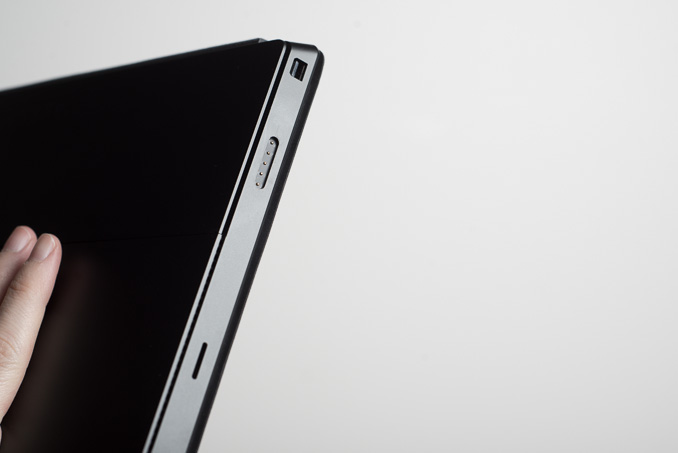
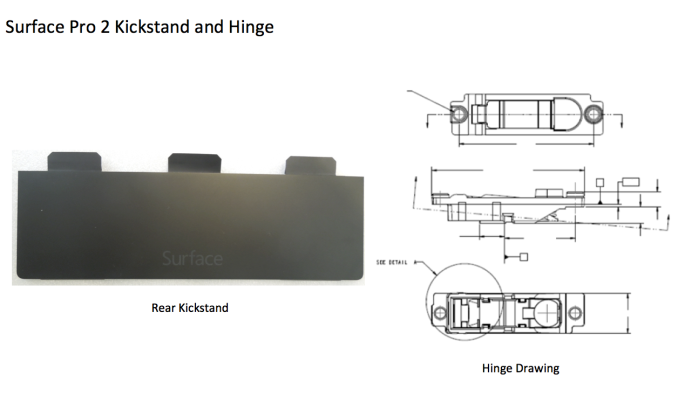
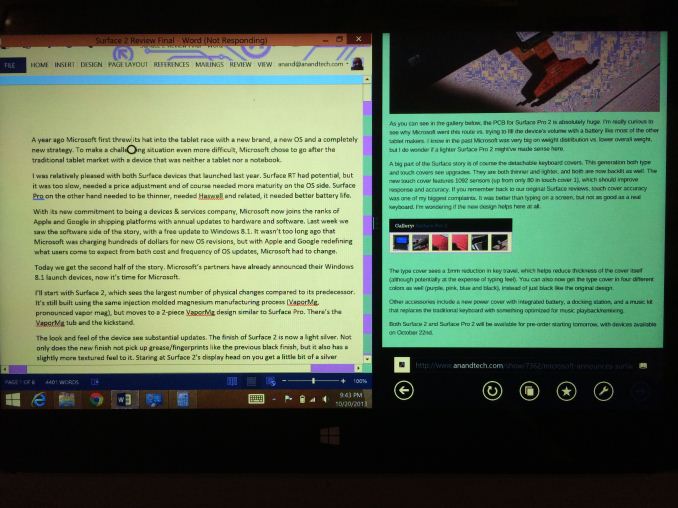


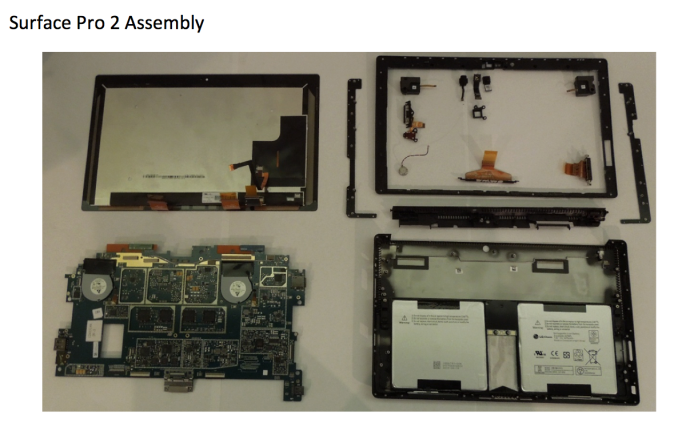
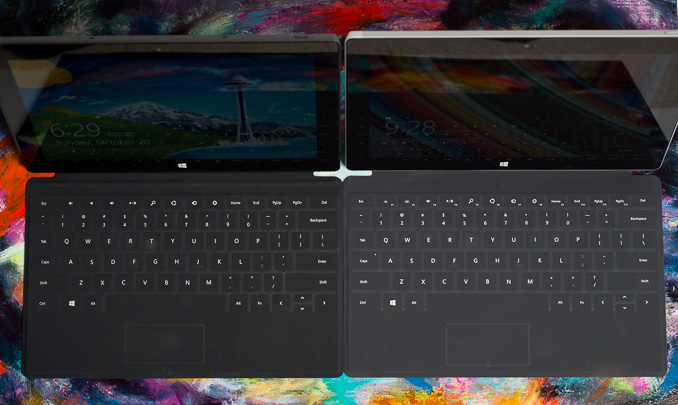








277 Comments
View All Comments
JumpingJack - Monday, October 21, 2013 - link
I believe he was making an "emperor's new clothes" type argument.beggerking@yahoo.com - Monday, October 21, 2013 - link
you should shut up until Air gets a touchscreen, or ipad gets a full OSXbackbydemand - Monday, October 21, 2013 - link
And when it does it will be "magical" and "innovative"KPOM - Monday, October 21, 2013 - link
I don't see the Air ever getting a touchscreen, or iPad ever getting OS X. I do see Apple's push to get the iPhone and iPad 64-bit processors as the first step in a massive improvement in iOS. Witness that everyone who buys an iOS device now gets Pages, Numbers, and Keynote. While they aren't up to Office standards, it's a sign that Apple wants to make iOS a "real" operating system. It's a logical strategy. iOS has a bigger market share than OS X.Therefore, Apple appears to be making a play to scale its mobile OS up to more powerful devices. It's starting from Apple's position of strength.Likewise, Microsoft is starting from its position of strength. Windows (for PCs) has a bigger market share than Windows Phone/Mobile ever did. Therefore, Microsoft is attempting to scale its PC OS down to mobile devices.
teiglin - Monday, October 21, 2013 - link
Thanks for the reviews as always. Never thought I'd see Penny Arcade cross-pollination in Anandtech!I'm still rather conflicted on your recent uptick of "on time" reviews--I know it's important (to OEMs and readers both) to get the reviews out right away at embargo lift, but I do miss the obsessive completeness of your dates-be-damned-we'll-finish-when-we-finish reviews. I do hope you'll consider putting off some of your full reviews and make sure you get every single test done that you want to run--I really miss your bevy of wifi quality tests, for example. Personally I like when you post quick impressions early but then follow on with the comprehensive review later.
takeship - Monday, October 21, 2013 - link
Another solution would be for someone do a moments after NDA expiry pod review, and then follow that up a few days/week later as necessary with a full fat review from one of the other writers. If I remember right, wasn't that done with the 2013 Mac Book Air review a few months ago? Best of both worlds. It may be a bit redundant, but most of us would read them both anyways.guste - Monday, October 21, 2013 - link
Completely agree with this post. I currently use a mid-2011 11.6" MBA and as a university student, the use cases of the Surface Pro 2 are really compelling. I've already seen a few of the original Surface Pros around classrooms and labs and so I pre-ordered one to give it a go. I was really hoping for a bit more here. I expect nothing useful from most other sites, but there's always a lot of meat on the bone here, so to speak.Anand, is there any possibility of you revisiting the Pro, with a more thorough follow-up?
frostyfiredude - Monday, October 21, 2013 - link
Are we the same person? I'm in the exact same boat here considering moving from the 11" 2011 Air to a Pro2 after having seen some classmates and profs pickup the original Pro. I've heard the phrase "this is the best purchase I've made in a long time" quite a few times in response to queries on the device.I'm in engineering so the pen will be awesome for technical drawings and all the graphs in our notes, something which has made the Air significantly less useful than expected.
guste - Monday, October 21, 2013 - link
We must be the same person, as I'm also in engineering (physics)... Or, more likely, there are a few of us that are looking for something life a bit easier.I came really close to getting the Pro last year, but that battery life was abysmal and frankly, I couldn't justify getting a new computer after one year anyway. The mid-2011 Air is still a fantastic machine and I've come to admire Mac OSX to the point that I'm a bit apprehensive about going back to Windows on a full-time basis. I think that's where my desire for a top notch Anand review is coming from and why I'm a bit deflated at the moment. It's not going to stop me from trying out the Pro for the next couple of weeks and making my own determination, but I'm still holding out hope for a follow-up.
guste - Monday, October 21, 2013 - link
Looks like Anand will be going more in-depth:https://twitter.com/anandshimpi/status/39214496614...
It may take some time though, as he's just flown out to cover the Apple event.
What concerns me is the conversation that follows the initial tweet, about the power optimization of Mac OSX vs. Windows. Some guy is comparing a 1366x768 MBA to the 1080P screen with a digitizer on the SP2. Power optimization is undoubtedly worse under Windows, but both he and Anand compared apples to oranges without batting an eye.